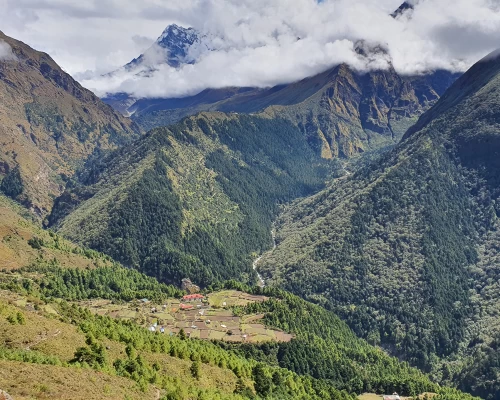Adventure at the base of the world's highest peak, Mt Everest, with a sweeping panoramic view of Khumbu Ice Falls and glaciers.
The Everest Base Camp Trekking with Explorer Adventurer takes you through an unforgettable journey filled with pristine moments and lasting experiences. This journey takes us through the scenic trails located right on the lap of the world's highest mountain, Everest, surrounded by the stunning arrays of the grand peaks.
This journey is not just a trekking adventure but a class high country walk. In this journey, we experience the impressive cultures of the famous highlanders, the sherpas. This tribe is globally famous for being the best mountaineering guides out there. Therefore, on this trek, we will be accompanied by the native sherpa guide. They guide us through the wonders of the great Himalayas and around the beautiful areas of Everest.
Everest base camp trekking takes us through the lovely trail up to Pangboche, the last permanent village en route to Everest Base Camp. Along with this, we can also encounter many temporary settlements that cater to our needs. These temporary settlements provide us with good lodges and food around Dingboche, Pheriche, Lobuche, and Gorakshep.
On the walks, we can explore the traditional villages adorned with the religious monuments of Tibetan Buddhism. Furthermore, we can also enjoy the rich Tibetan heritage and culture. Throughout the way, we can enjoy the stunning views of the great snow-capped mountains. In this journey, the beauty of the beautiful and scenic giant peak fills us with calmness, and the hospitality of the Sherpa fills us with warmth.
Eventually, the adventure takes us beneath the majestic Mount Everest, located amidst the chilling fields of ice and glaciers. After a few days of tough but rewarding walks, we follow the river upstream to the famous Namche Bazar. As the trek progresses, we reach the beautiful area of Tengboche, along with the monastery surrounded by a series of peaks.
Here, we face the toughest part of the journey: the rapid gain in altitude. Therefore, from here on, we ascend slowly to overcome the effects of acute mountain sickness. One of the prime areas to do this is in the areas of Namche Bazar. Along with this, the beautiful Imjatse Valley in Dingboche is also another great place to acclimatize. Then, we head towards the main highlight of the adventure.
After reaching the Everest Base Camp, we can enjoy the thrill of standing next to the massif of Khumbu ice-fall and glaciers. This location is enclosed between the giant peaks of Lhotse, Nuptse, and Pumori. The next phase of our adventure takes us to the top of Kalapatthar, the highest point of the trek. From Kalapatthar, we can enjoy the spectacular panoramic view of the snow-capped mountains as we face the mountain Everest at a close distance.
After a wonderful experience, we take a return journey downhill to Namche Bazaar and back to Lukla. There, we stop for a last overnight stay in the Khumbu area.
The next morning after that, we take a quick panoramic flight back to Kathmandu.
Read this next:

















